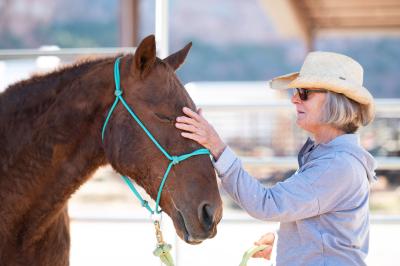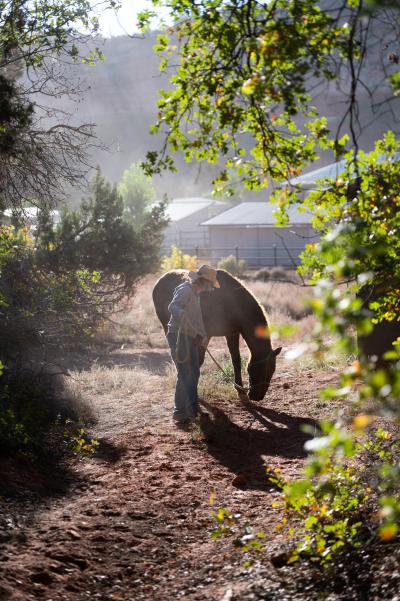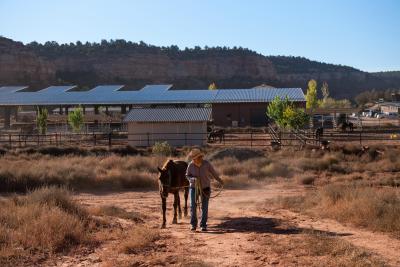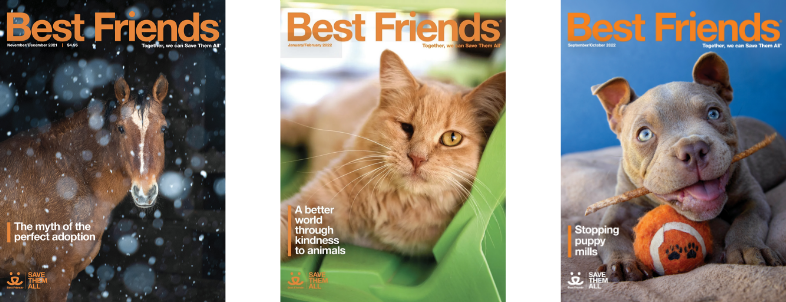Curly-coated horse gets a personal trainer

“Help, I’ve fallen, and I can’t get up!” You’ve probably seen or heard of this commercial. Well, recently, that was a very real part of senior horse Curly Sue’s life. She wouldn’t fall, but if she lay down for a nap, she didn’t always have the strength to get herself back up unassisted.
“She would never panic,” explains Jen Reid, manager of Horse Haven at Best Friends Animal Sanctuary. “She would just lie there like: ‘This is how I live now.’” Of course, it did worry her caregivers, who were quick to help her back to her feet each time she got stuck.
Curly Sue has always needed some extra-special care; the recessive genes that make her coat so delightfully curly came with a laundry list of medical issues. She has very sensitive skin, which means she occasionally gets baths with a gentle rosewater shampoo. She is prone to mouth ulcers, so she gets special food soaked in water to make it easier for her to eat. She also needs special rubber shoes due to a history of laminitis, or inflammation and damage to the tissue of her feet.
[Wild mustang mares and foals make Best Friends their winter rest stop]
And now, at 26 years old, Curly Sue was starting to lose muscle mass — not that uncommon as we get older. What she needed was exercise, but she wasn’t particularly self-motivated in that area (which many of us can probably relate to).
The solution? Find Curly Sue a personal trainer — someone who could help her build back up that muscle tone and, eventually, get her standing up on her own. And Jen knew just the person to ask.

A personal, ‘horse-onal’ trainer
Karin Hamilton is a local volunteer who’d been working with several other senior horses at the Sanctuary, getting them out four times a week for both exercise and enrichment. And when Jen approached her about adding Curly Sue to her roster of walkers, Karin was more than happy to oblige.
As an avid runner, Karin knows how important it is for people who aren’t used to a lot of exercise to work their way up slowly. “If you’re going into a training program for running, you need a little hill work, and you need some speed, and you need some endurance,” Karin explains. “And I thought it shouldn’t be too different [for Curly Sue].”
So that’s what they did. Three times a week, Karin gets a halter on Curly Sue, and they hit the trail, headed for the hills. They climb up, and up, and up, until they reach the top. Of course, the going is slow, with plenty of little pauses along the way and then a big break at the top for both of them to catch their breath.
“She does not like going too far away from where she’s comfortable,” says Karin. “She would give me a lot of resistance the farther away that we got. And then once we turn around, it’s like a flash — she’s ready to go home.”
That did make adding some speed work to their return trips pretty easy, though. Curly Sue would already be picking up the pace to head back, so building that up to a jog and then a trot just worked.
When it came time to add endurance, Karin kept the pace steady like she had with everything before. On their first trip without big hills or speed, Karin and Curly Sue walked just half a mile. Then, the next time, they added another tenth of a mile. And another tenth. And another.
It was on those walks that Curly Sue’s desire just to go back home and nap became extra apparent. There were certain spots she would “stall out” and need to be convinced to keep going. She’d pull over to the side of the road and nibble on young tumbleweeds or long desert grasses. And while Karin always made sure they reached their next distance marker, she let Curly Sue take her time and have her munchies (though she did try to discourage her from the pokey tumbleweeds).
“If you’re running a longer distance, you want to bring a little fuel with you,” Karin says and laughs. “Horses aren’t going to pack along jellybeans or whatever, so snacking on grass works.”

Strong senior horse
Finally, after building to it over several weeks, Curly Sue and Karin reached their distance goal: walking from Horse Haven HQ to the Sanctuary’s welcome center and back, a one-and-a-half-mile round trip.
In just a few months, with Karin’s help, Curly Sue’s muscles had definition again. Her legs looked stronger and sturdier. She could make the full trip up and down the hill or to the welcome center and back without a problem. And if she had some friends along — other volunteers, staff or her pasture mate — she was even happier to keep up the pace.
[U.S Forest Service mule coasts into retirement]
Most importantly, though, when Curly Sue settles down for a nap, she’s able to get herself back up afterward without any help. She doesn’t need anyone to rush to her rescue anymore, and that old commercial catchphrase is no longer Curly Sue’s go-to.
“All the horses have somebody assigned to them for training,” says Karin. “And I just feel blessed that they put my name next to Curly Sue. I’m very happy about that. She’s a very special horse.”

This article was originally published in the January/February 2023 issue of Best Friends magazine. Want more good news? Become a member and get stories like this six times a year.
Make a difference for horses
By joining Best Friends, you can make a difference in the lives of even more horses like Curly Sue.
